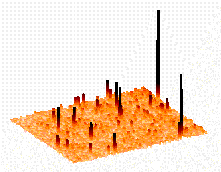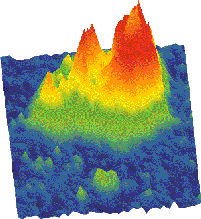
 Experimental results were obtained this past year from
the first beamline to be operational at LBL's Advanced Light Source, the
nation's premier source of x-ray and ultraviolet light for science and
industry. These results, obtained by researchers with LBL's Earth Sciences
Division (ESD) and by researchers with Miles Laboratories in Pittsburgh,
Pennsylvania, were made possible by the unprecedented properties of the
beamline's light which serves as an x-ray fluorescence microprobe.
Experimental results were obtained this past year from
the first beamline to be operational at LBL's Advanced Light Source, the
nation's premier source of x-ray and ultraviolet light for science and
industry. These results, obtained by researchers with LBL's Earth Sciences
Division (ESD) and by researchers with Miles Laboratories in Pittsburgh,
Pennsylvania, were made possible by the unprecedented properties of the
beamline's light which serves as an x-ray fluorescence microprobe.

Researchers are using the x-ray microprobe beamline to help them determine the cause of defects in solar cells. This computer image reveals trace concentrations of iron particles in the defective areas of the cell.
Al Thompson at LBL's Center for X-ray Optics (CXRO) led the development of the microprobe beamline, which is the longest at the ALS, measuring some 32 meters in length from its point of origin at bending magnet port 10.3 to its experimental hutch. The x-ray fluorescence microprobe beam is capable of simultaneously detecting and measuring the presence of elements from potassium to zinc in amounts as small as a millionth of a billionth of a gram. Measurements are provided through a pair of elliptical multi-layer mirrors and a solid-state silicon-lithium detector. A beam of x-rays is focused down to a spot size of 1.5 x 3.2 microns, strikes a sample and causes constituent elements to fluoresce at characteristic energies that are recorded by the detector.ESD's Tetsu Tokunaga was one of the first researchers to capitalize on the beamline's unique capabilities. Using a technique called synchrotron x-ray fluorescence microprobe mapping (SXRFM), he analyzed soils from polluted wetlands around the San Francisco Bay to measure concentrations of chromium, an environmental contaminant with carcinogenic potential. Chromium ions in the soil appear in one of two forms: Cr+3, which is essentially insoluble; or Cr+6, the form used by industry in chrome plating. Cr+6 is toxic and soluble, meaning it moves through the environment.

A computer image, generated on the x-ray fluorescence microprobe beamline, shows that chromium is drawn to highly localized chemical hotspots in the soil. The color scale ranges from blue, which is no chromium, to red-orange, which is a concentration of one picogram per micrometer. The sample was taken from a polluted San Francisco Bay wetland.
Tokunaga's analysis revealed that Cr+6 in the environment can be drawn to specific microsites where chemical conditions enable it to convert to insoluble Cr+3. This indicates that the strategic placement of chromium reducing agents, such as organic matter, could be used to remediate chromium-contaminated soils. In another set of experiments, the new beamline aided researchers from Miles Laboratories who were finding defects in some areas of their solar cells. The researchers were trying to determine whether the defects arose as a result of trace element contamination during the manufacturing process or during the crystal-growing process. The solar cells are made of poly-crystalline silicon, and grain boundaries between individual crystals can be the site of defects. Knowing the source of their defects will enable the researchers to take corrective action.Using CXRO's x-ray microprobe to analyze sample cells, they found trace concentrations of iron particles in defective areas of the cells but not in areas that were good. More experiments are planned to continue this investigation and look for trace elements near the grain boundaries.
-- Lynn Yarris
 Return to Highlights Table of Contents
Return to Highlights Table of Contents